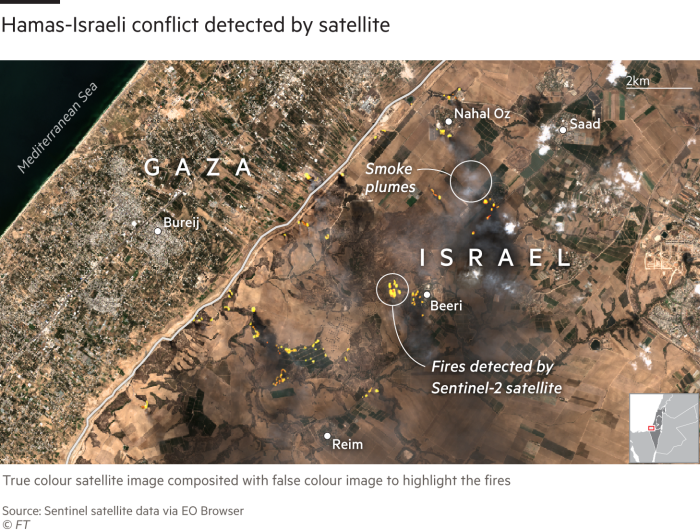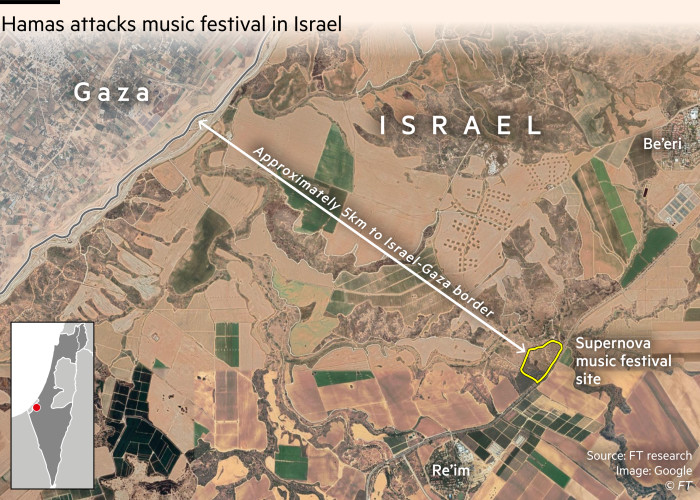The Israel-Hamas war in maps and charts

Roula Khalaf, Editor of the FT, selects her favourite stories in this weekly newsletter.
Israel-Hamas war
The Israel Defense Forces launched air and land offensives in Gaza in response to Hamas’s deadly October 7 2023 cross-border assault in southern Israel.
Hamas killed more than 1,200 people and seized about 250 hostages during the attack, according to Israeli officials, who say around 100 hostages remain in captivity.
Israeli negotiators have held talks with mediators in Qatar about a ceasefire with Hamas and the release of hostages, as the two sides edge closer to a deal before US president-elect Donald Trump takes office in January.
After October 7 2023, the IDF moved into northern Gaza before sweeping south towards Khan Younis and then Rafah, before returning back to the north in October 2024. More than 2mn people in Gaza have been displaced by the conflict, with many leaving Rafah and some moving to al-Mawasi or other IDF-declared “humanitarian areas”.
The death toll from Israel’s offensive in Gaza passed 45,000 in December, according to Palestinian health officials and data from UN OCHA.
Nearly 750 Palestinians in the West Bank and about 1,900 Israelis and foreign nationals in Israel have been killed since October 2023, according to data from UN OCHA and Israeli human rights group B’Tselem.
Humanitarian workers inside Gaza have also faced significant danger during the conflict, with an unprecedented number being killed.
Food and water insecurity in Gaza
Aid to Gaza is close to all-time lows despite the US saying it had seen “some progress” with humanitarian aid reaching the enclave.
About 1,700 trucks entered the enclave in the month to December 12, according to UN data, just over 100 more than in the preceding month, when aid deliveries hit their lowest point since the start of the conflict.
The US built a $230mn JLOTS floating pier to get more aid into Gaza, but shipments were affected by storms and sea conditions, leading to the project being mothballed in July. Two additional crossings — Gate 96 and Kissufim — have since opened, but this has had little impact on overall aid flow.
The IPC, an international panel of experts who monitor food insecurity, has warned that the entire Gaza strip is at risk of famine, particularly in the north where Israel has blocked the entry of supplies almost completely.
Infrastructure damage in Gaza
According to damage assessments from researchers at the CUNY Graduate Center and Oregon State University, more than half of all buildings across the Gaza Strip have suffered damage, rising to nearly 80 per cent in Gaza City.
The damage in Khan Younis and Rafah has also increased as Israel expanded its offensive from northern Gaza to the rest of the territory.

Israel-Hizbollah war
The fragile ceasefire established on November 27 between Hizbollah and Israel after more than a year of conflict has remained in place despite several violation accusations over the past few weeks.
According to the terms of the US-brokered agreement, Hizbollah is required to withdraw beyond the Litani river up to 30km north of the contested Israel-Lebanon border, known as the UN “blue line”.
Israeli forces are meant to withdraw from Lebanon over a 60-day period and to be replaced by the Lebanese army and UN peacekeepers.
More than 1mn Lebanese and around 60,000 Israelis had been displaced by the conflict, which has killed over 3,800 people in Lebanon and 140 in Israel.
The fighting was triggered by Iran-backed Hizbollah firing into northern Israel in the days after Hamas’s October 7 2023 attack on Israel.
Hamas’s October 7 attack on Israel
Hamas militants launched a multipronged dawn assault on Israel from the Gaza strip on October 7 2023.
The attack began in the early hours of the morning on the Jewish holiday of Simchat Torah, with thousands of rockets fired at Israeli towns and cities. Many were intercepted by Israel’s Iron Dome defence system, but satellite imagery showed fires and smoke rising from locations that were hit.

Hundreds of Hamas fighters simultaneously attacked by land, air and sea, breaching the fortified barrier between Gaza and Israel.
Militants used motorised paragliders to attack the Supernova music festival, which was taking place not far from the Gaza border. After flying in, they shot many Israelis and took others as hostages.

Armed Hamas fighters targeted Israeli communities and military sites at several locations, going door-to-door and performing execution-style killings as well as taking hostages.
More than 1,200 Israeli civilians and troops were killed on October 7, according to Israeli officials — making it the deadliest attack on the country since its foundation.
Since Hamas’s attack, Israel has been in conflict across several fronts in the Middle East connected to Iran’s “Axis of Resistance”.
Additional cartography by Jana Tauschinski and Cleve Jones
Development by Janina Conboye, Peter Andringa, Chris Campbell, Chris Cook, Sam Joiner, Lucy Rodgers, Ian Bott, Dan Clark and Alan Smith













Comments